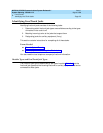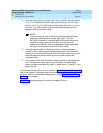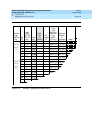
MERLIN LEGENDCommunications System Release 6.1
System Planning
555-661-112
Issue 1
August 1998
Lines/Trunks
Page 3-7Identifying Line/Trunk Jacks
3
2. If the jack type shown in the Jack Type column is GS/LS, then write either
GS or LS to indicate the line/trunk type in the Incoming Line/Trunk Type
column. For a T1 or NI-1 BRI trunk not used at this time, write
unequipped.
For other T1 or PRI facilities, the kind of service connected (such as
Megacom 800) will be filled in later.
NOTE:
In the next step, be sure the line/trunk type associated with each
telephone number matches the jack type. Also, if you have
800 NI-BRI modules or have dedicated 100D module channels to
emulate loop-start, ground-start, and/or tie trunks, the local
telephone company will supply the telephone number associated
with each of the channels on the BRI or DS1 facility.
3. In the Telephone Number or Equipment column, write the telephone
number for each incoming line/trunk (as supplied by the local telephone
company) on the row with the logical ID for its line/trunk jack. If you do not
know the telephone number, leave the column blank and enter the
information later.
4. In the Label column, write the label for each line/trunk on the appropriate
line. The labels can contain up to seven characters, including capital
letters, numbers, ampersand (&), dash (-), space, colon (:), asterisk (*), and
pound sign (#).
The remaining entries on this form are covered in “Selecting Line/Trunk Options,”
later in this chapter. If the system does not have auxiliary equipment (for example,
Music On Hold or a loudspeaker paging system), skip to “Selecting Line/Trunk
Options” in this chapter.
Figure 3–1
shows an example of a partially completed Form 2c.


















